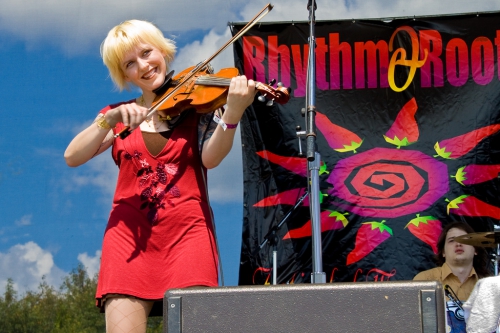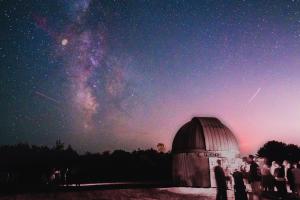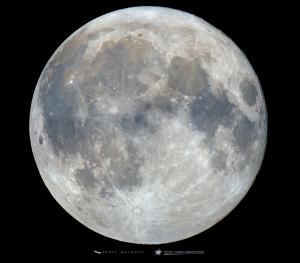
Summer Stargazing Nights - Rhythm and Roots
- Where:
- Frosty Drew Observatory
- When:
- Friday September 1, 2017 at 6:00 p.m
- Cost:
- $1 Suggested Donation per Person
Tonight is Rhythm and Roots at Frosty Drew Observatory and the forecast is looking okay. We can expect mostly clear skies with periods of partly cloudy activity. Though the bright 80% waxing gibbous Moon and Saturn will offer up many spectacular views in between passing clouds. Add in that the fabulous Rhythm and Roots music festival is in the Park with us this weekend and we will have a fantastic night of Americana tunes alongside views of Saturn’s rings, the cratered surface of the Moon, and more. We also have a huge Near Earth Asteroid (NEA) passing tonight, the largest NEA in the history of NEA tracking!
We will open the Observatory shortly after 6:00 p.m. If skies are clear enough, we will setup our Hydrogen Alpha telescope offering views of the solar chromosphere, including sunspots and prominence. Once the Sun sets we will switch over to the Moon, Saturn, binary stars, and more. Once twilight starts to wane we will have images of NEA Asteroid 3122 Florence on the screen in the observatory as well as periodically in our big telescope. We will keep the Sky Theatre closed tonight due to the high volume of festival attendees in the Park. The Observatory will stay open until 11:30 p.m., perhaps much later if the skies are playing nice.
Overall, tonight looks fantastic! Live music, a lively bustle, a Near Earth Asteroid pass, and relatively clear skies will make for a rock out night. If dark skies are your digs, the Moon and the extra light from the festival will make this a night to skip, though the Moon is in an excellent phase for vibrant views of Copernicus Crater, Tycho Crater and Sinus Iridum. Cloud forecasts are a bit variable at this time, though nothing too threatening. We will post updates to our Twitter (@FrostyDrewOBSY) and Facebook as the night progresses, as well as a “Closing up” message when we decide to crash. So head out for a rock star night at Frosty Drew Observatory and catch sight of a 2.7 mile wide asteroid zooming by.
--------------------
Weekly Happenings
Scott MacNeill
Tonight, Friday, September 1, a large Near Earth Asteroid (NEA) will pass Earth at a distance of about 18 times the Earth-Moon distance. The NEA is called Asteroid 3122 Florence, or just “Florence” and measures in at 2.7 miles in diameter. Discovered in 1981 by Schelte Bus at the Siding Spring Observatory in Australia, the asteroid was named in honor of Florence Nightingale. Florence is the largest asteroid to pass Earth at such a close distance since the start of NEA tracking began, which will make for easy visibility in most backyard telescopes. Catch sight of Florence as it passes through the constellation Delphinus tonight, which borders east of the Summer Triangle asterism, and will be about magnitude 8.5, the brightness of Neptune. Movement should be noticeable when observing in a telescope over a period of a couple minutes. Sorry doomsayers, though a fabulous pass it is, at 4.4 million miles distant, there is certainly no threat of impact. Tonight’s encounter will be the closest pass of this asteroid since 1890, with the next close pass happening after 2500.
Tonight will be our last Summer Stargazing Nights event for the 2017 summer break. Starting next Friday, we will resume our standard Stargazing Nights public viewing program starting about 30 minutes after sunset. Though we are finishing off the summer season with a bang of clear nights and fantastic events, summer 2017 has been a difficult time at Frosty Drew Observatory with relentlessly cloudy Friday nights. Every week, we pushed through and attempted to catch the best views we could through the clouds, though we only had one fabulous night of viewing for the entire period, which was last Friday night. We hope the change in weather we have seen over the past couple weeks stays with us as we move into autumn and through the winter. Thanks to all who have been patient with us as we drudged through the difficult weather!
Early Wednesday morning, September 6th the Full Moon will occur. Called the Full Corn Moon, this is the last Full Moon before the Harvest Moon, which occurs on Thursday, October 5th. Maybe catch the Pawtuxet Village Sidewalk Astronomers out on the bridge on night around the Full Moon.
On Tuesday, September 5th, Neptune will be at opposition. This occurs when the Earth arrives at the point it our orbit around the Sun where Neptune is on the opposite side of the Earth than the Sun. Consequently, this is our closest approach to Neptune for our year and places Neptune in best viewing. Over the next month or so, we will frequently observe Neptune in our telescopes at Frosty Drew Observatory.
-Scott



